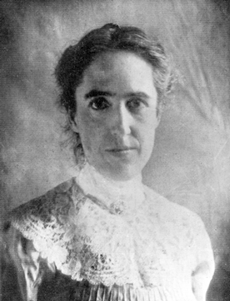
The second female scientist I'm going to introduce is Henrietta Swan Leavitt. Her groundbreaking discovery forever changed our view of the Universe... have you heard of her?
If you haven't studied astronomy, chances are you aren't familiar with her name. She was a hard worker - never married, never had children - and in the end, like many females, she never received any recognition during her own lifetime.
- Henrietta Leavitt discovered Cepheid variables, which allowed Edwin Hubble to measure distances between stars, planets and galaxies. The Cepheid variables also enabled him to discover that other galaxies exist outside of ours, the Milky Way Galaxy.
- A Cepheid variable is actually a star. Variable stars pulsate, changing in size and luminosity (brightness). What makes a variable star a Cepheid is the relationship between the luminosity and period: the star will become brightest (and dimmest) at a distinct interval.
 It's like a sine (or cosine) curve, which I'm showing at the left. Imagine one of the lines as the luminosity: it always increases and decreases to the same level of brightness, and each cycle always takes the same amount of time. Somehow (I don't know the exact mechanics) this is used as a ruler to measure distances in the Universe.
It's like a sine (or cosine) curve, which I'm showing at the left. Imagine one of the lines as the luminosity: it always increases and decreases to the same level of brightness, and each cycle always takes the same amount of time. Somehow (I don't know the exact mechanics) this is used as a ruler to measure distances in the Universe. - Henrietta discovered these stars while working at Harvard College Observatory. She was employed as a computer. That's right - before the PC, a computer was actually a job title. Henrietta was part of "Pickering's Harem," the first group of female computers (previously only a man's job). This of course freed the men to do more important (& fun) work, with telescopes, for example (which women were not allowed to use).
.jpg)
- Henrietta started working at the Observatory in 1893 & published her findings in 1908 - only 15 years, which is pretty impressive considering what she was doing. She measured and catalogued the brightness of stars from photographic plates. You can see an example of such a plate at the right. From these, she began to see a pattern, leading to her publication.
- After that, Henrietta's health declined. An illness left her almost completely deaf & she never fully recovered, probably due to the questionable medical practices at the time.
- She was appointed head of Stellar Photometry in 1921 by the new director of the Observatory, Harlow Shapley, but died later that year of cancer. Four years later, Gösta Mittag-Leffler of the Swedish Academy of Science contacted Shapley about Henrietta, intending to nominate her for the Nobel Prize in Physics. She never was, since the Nobel prize is not awarded posthumously, but the real insult came from Shapley, who suggested that he deserved the credit for the interpretation of her work.

U look like her!!
ReplyDelete